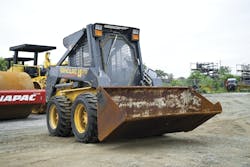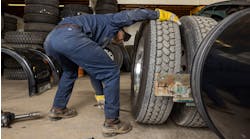Skid steer tread patterns go from all-purpose to purpose-built
Dealers have more choices than ever when matching skid steer tire tread patterns to specific applications for their customers. “The skid steer product line looks a lot more like a small OTR or medium truck type of offering now,” says Nick Phillippi, general manager of Nebraskaland Tire Co. Inc., which also does business as Kansasland Tire and Coloradoland Tire.
Dealers now have opportunities to stock tread patterns, tread depths and ply ratings, as well as radial and all-steel skid steer tires, that did not exist just five years ago.
“Ten years ago we were still dealing with two or three tread patterns,” says Phillippi. “The Denman and Galaxy brands were the leaders trying to get different patterns and styles involved with a specific tire. But Titan, Michelin and everybody else started doing the same thing in the last five years.”
Nebraskaland Tire’s primary brand in the agricultural and skid steer market is the Goodyear Farm Tire brand manufactured by Titan Tire Corp.; the company also stocks the Michelin, Galaxy and Alliance brands. Skid steer tires are part of the company’s specialty tire offering, which also includes lawn and garden, ATV, solids and forklift tires. Specialty tires are less than 5% of the company’s total sales. Of Nebraskaland Tire’s 41 stores, 21 are commercial/retail, 18 are retail, two are commercial and one is a wholesale outlet. The company is tied for No. 24 on the Modern Tire Dealer 100.
Three designs for 99% of market
Quentin Martin, owner of Martin’s Tire & Alignment Center, stocks three tread designs from Alliance Tire Americas Inc. that “pretty much take care of the demand” in his market. Skid steer tires represent about 10% of tire sales at his nine-bay store in Morgantown, Pa., and his five-bay outlet in Narvon, Pa. Martin employs 16 people at the two locations, which provide commercial and retail sales and service.
Martin says three tread designs cover 99% of his market: a turf design for skid steers in lawn and garden applications, standard skid steer patterns like the Beefy Baby or the Muddy Buddy, and the Galaxy Hulk, a hard surface-design.
“I think those three patterns are going to continue. There is some radial; radial is starting to come on a little bit. It hasn’t taken a huge amount of the market because of pricing, it’s about double. Radial sales are primarily in construction. They’re seeing a lot less repairs with an all-steel casing,” says Martin.
‘You have to stock more’
“The skid steer has been around for a long time,” says Steve Jones of Ken Jones Inc. in Worcester, Mass. “Now there are more uses for that type of equipment. So there needs to be tires that suit those purposes.”
More tread designs have helped wholesalers meet the demand for skid steer tires, according to Jones. “The skid steer business as a percentage of our business has grown by a few percent just because of all the applications that these machines have uses for. If you have it, you’ll sell it. It’s tough for some smaller dealers to keep that stuff in stock because it ties up a lot of money. If we have it in stock, it helps our wholesale business quite a bit.”
Jones and his brothers, Brian and Darren, own the wholesale and retail dealership, which stocks the Titan, Carlisle, Galaxy, Armour and BKT skid steer brands. “You have to stock more,” says Jones. “Just like anything else in the tire business, people want options so you have to have those options. So we try to stock all the different tread designs.”
Although there are more tread patterns, sizing has not changed dramatically, according to Phillippi. “Size proliferation really has not been a tremendous issue. It’s more about the available tread patterns and casing style.”
Developments in casing style over the past five years include radial construction, heavier ply ratings and all-steel versus bead-to-bead steel. “All those things have added to the need to carry some more inventory. It’s much more application sensitive than it used to be,” says Phillippi.
[PAGEBREAK]
The newer product offerings from manufacturers tend to be more costly. “Most of what has come in recently has been toward the premium side of the market,” says Phillippi. “There’s not been a move to the bottom on pricing. It’s been more about technology and benefits of the tire as opposed to pricing.”
The right design improves performance
Steve Vandegrift, product and pricing manager for Alliance Tire Americas, predicts the interest in various tread designs will expand.
“Businesses, whether they’re warehouses or construction operations or farms, are being managed more carefully every day. Every penny that’s invested in the business has to show a return; every penny has to improve efficiency and profit. I think there’s a growing recognition that tires are an important part of outfitting equipment and keeping it productive.
“If you look at where skid steers operate, many of them are well-served by a classic bar tread. But not every skid steer is working in the same environment. To help that machine be as productive as possible in the conditions it’s in, specialized tread designs have become a valuable tool. As more owners recognize the impact of operator fatigue on their bottom line, I think we’ll see even more interest in features that improve ride, stability and performance to keep those operators comfortable and productive.”
Vandegrift says Alliance’s Beefy Baby tread is versatile and effective in a variety of situations, but feedback from customers who want treads for specific applications led to the development of other patterns. These include the Beefy Baby III, which offers better stability and performance; the Muddy Buddy, which delivers better traction in mud and manure through a unique lug design and 55% deeper tread; and the new Trac Star ND tire, which provides excellent wear for municipal fleets and utilities that run their skid steers on the road.
The Galaxy Mighty Mow for turf and lawn applications is probably the easiest difference in tread design to recognize, according to Vandegrift. But developing a tire for gentle operation in sensitive areas goes beyond a distinctive tread pattern. “The design includes rounded shoulders to avoid digging up divots on wet turf or when the skid steer is turning. In tire designing, it’s all about the details,” says Vandegrift.
“Not all tread lugs are created equal, and that really shows up in the details on some of our skid steer tire designs,” says Vandegrift. “Mud breakers help keep the Marathoner tread clean and improve traction, while sharp shoulders add grip in the Muddy Buddy. Deeper tread adds service life on many of our tires. When dealers point out those details to their customers, they can really help them get the best possible performance from their equipment.”
Expect more specialty patterns
Attempts by tire manufacturers to fit the different demands of the market are responsible for the increase in the number of skid steer tread designs in the last several years, according to James Crouch, North America farm segment marketing manager for Michelin North America Inc.
He says Michelin offers two skid steer tread designs, the Bibsteel All Terrain and the Bibsteel Hard Surface, to fit two different customer demands. “The Bibsteel All Terrain is a ‘traditional’ R4 tread pattern that is optimized for use in off-road applications. This type of tread design is still the most popular in the market. It offers the customer a long tread life while prioritizing traction.”
Michelin’s second tread design for the skid steer market is the Bibsteel Hard Surface, a tread design that has blocky shoulders and a solid center rib. The tire was designed for those who work on hard surfaces such as asphalt and concrete and need a tread that will provide an extremely long tread life and improved casing durability, according to Crouch.
“We do expect this trend of specialty tread designs to continue because, very similar to the passenger car tire market, applications across different markets are very different and can’t be satisfied by one standard tread design, says Crouch.
Michelin also sells an airless tire called the Tweel for use on skid-steer loaders. Michelin says the Tweel, which uses traditional radial tire technology, performs like a pneumatic tire but without the risk and downtime associated with penetrations and impact damage.
Michelin introduced the technology in 2005. Several dealerships in the U.S. and four in Canada began commercial sales of the Tweel in October 2012 for use on skid steers used in the construction, landscaping, contracting, refuse/recycling and agricultural industries.
[PAGEBREAK]
Jack’s Tire and Oil Management Co. Inc., which does business as Jack’s Tire and Oil Inc., began selling the Tweel product in November 2013. CEO and President Bob Feldbauer says the company has sold about 50 tires and customers like it so far. “We’re in on it early enough that the feedback would be limited and more guessing than factual,” he says.
Feldbauer says the Tweel is not going to be the complete answer because of the many environments skid steers are used in, but it is something new to talk about with customers. “It’s a lot more expensive, but we haven’t had difficulty selling it. It comes in spurts. Being in Utah you can only sell them between April and August because the snow starts coming down and skid steer use drops.” Jack’s Tire and Oil is tied for No. 98 on the MTD 100 with seven commercial/retail outlets, three commercial stores and one retail store. The stores are located in Utah, Idaho, California and Arizona.
Tom Van Ormer, director of purchasing for the East Bay Tire Co., an importer based in Fairfield, Calif., also sees an increase in tread pattern offerings. But he says these are not “radical or new” but are “replies” by overseas manufacturers to established patterns that have been available for several years from reputable suppliers.
“Many of the imports are copying already established designs and rushing them to the market, but they are really, in our eyes, not new ones, just copies. Our Dawg Pound offering has the standard bread and butter skid steer tread in the Big Dawg and Bad Dawg lines, but we also have a hard surface design for pavement and cement in our Ruff Dawg, a deep tread L-5 application in our Super Dawg, plus our own proprietary design in the Skid Dawg for dirt and hard surfaces as well as a solid tire in our Air Dawg. Our customers have started to understand which design works best on particular applications. They are not necessarily new designs, but instead using the right tire for the correct purpose.”
BKT Tires USA Inc. has also increased the number of skid steer tread patterns in its line-up. The company has developed tread designs for skid steers operating in loose soil, hard paved surfaces, snow, scrap yards and other applications under the Skid Power, Sure Trax, Jumbo Trax and Power Trax brands.
CTP Transportation Products LLC (CTP) also expects the trend for more treads to continue as customers look for ways to save money. “We are seeing a slight increase as far as people looking for something a little bit different trying to fine tune in on different applications,” says Adam Brown, product marketing manager, ag/construction.
While traditional designs work well for a wide number of applications, finding a design that can do a specific job a little better adds value, according to Brown. He cites CTP’s Carlisle Ultra Guard LVT line, which delivers both traction and durability for dairy farmers operating skid steers on their concrete milking pads. When conducting field tests of the LVT, the company found a dairy farm’s concrete pads to be one of the toughest and dirtiest applications for skid steer tires. “Customers were delighted because the LVT tire lasted for them and did the job they needed it to do.”
At Greenball Corp., the increase in interest for new and different skid steer patterns has been slight, according to Randy Tsai, director of marketing and GBC Motorsports. “We’ve seen in some cases a demand for a skid steer tire with a more closed void ratio for construction sites to reduce punctures. In other cases, skid steer tires with a more closed void ratio are more favorable for applications for smooth and hard surfaces as it provides more stability. Yet another reason is because in recent years the skid steer market has become so price driven, we’ve seen interest in different tread pattern designs just for product differentiation.
“There have been so many price point skid steer tires released into the market with the traditional lug/herring bone design in recent years that we now have interest for something different from customers. The hope is that the tire with a different design ends up being the selling point. We’ve received different input and requests from various customers, with a lot of the patterns similarly based off of OTR tire designs. We are carefully investigating designing skid steer tires with newer tread designs, but are hesitant because of the rock bottom pricing required to be competitive,” says Tsai.
Greenball believes the trend for newer designs will continue. “Newer tread designs brought about by functionality, application or aesthetics are inevitable. But the bottom line is that price is still the prevailing priority for our customers, which is why we are not blindly jumping into developing several new lines of skid steer tires. We quite simply have not seen the demand yet for the new tread designs for skid steer. Interest yes, demand no,” says Tsai.
Brown feels customers are beginning to ask more about tread patterns. “From a dealer’s perspective there’s value added if they can recommend the best tread pattern depending on the application the customer’s coming to them with.”
More tread patterns place a premium on learning about the different types of tires and how to match a tread pattern appropriate to the application. Phillippi suggests dealers assign a person or people to a specific market to increase sales. “We’ve found if we take somebody in our organization and say your job is to increase our skid steer business, they do the research, find the people, go to the shows and call on the dealers.” ■




